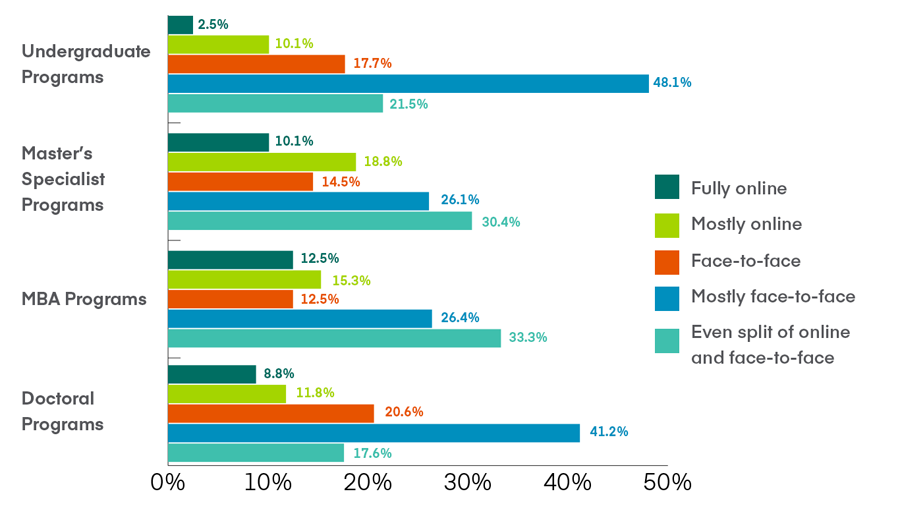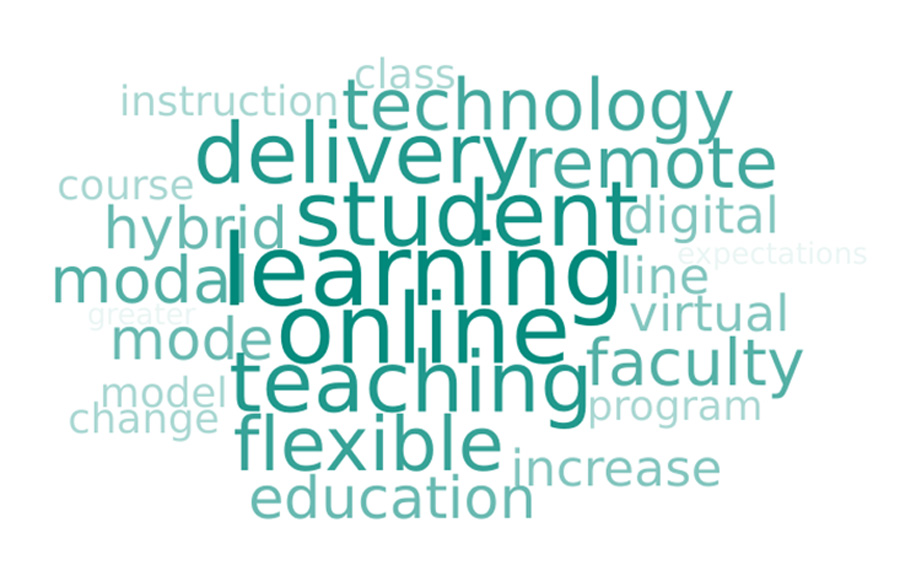The Impact of COVID-19: By the Numbers
There’s no question that COVID-19 turned education, at all levels, on its head. From the swift transition to online learning early in the crisis to the need to set policies for mask wearing, social distancing, and vaccination later on, schools have had to rethink how everyone on their campuses works, lives, and studies.
With the pandemic still ongoing, the long-lasting impact of COVID-19 remains difficult to quantify. But many organizations are trying to determine the near- and long-term effects that the crisis has had on higher education, by asking administrators, faculty, and students how they’ve weathered the last 18 months and what changes they believe have been the most significant so far.
Below is a sampling of data from several surveys—including a quick-take survey that AACSB conducted among its own membership in September. Taken together, the surveys’ results reveal that faculty, students, and staff haven’t just become more accustomed to virtual interaction and social distancing. They’re also better prepared to adjust course, if necessary, should their campuses have to close once again.
Master’s Programs Embrace Hybrid Delivery
In AACSB’s quick-take survey, most of the 90 respondents—nearly 83 percent—noted that the pandemic will have a lasting impact on their programs. It’s no surprise that they said the shift to online teaching and learning represents the single biggest impact the pandemic will have on the future of business education. Most expect that the way they deliver educational content will be permanently altered in some way, and several expect to see schools more rapidly adopt new technology and pedagogical approaches.
At the same time, only a small percentage of respondents in this sample indicated that they still are delivering most of their course content 100 percent online. Just 2.5 percent of their undergraduate programs, 10.1 percent of their specialized master’s programs, and 12.5 percent of MBA programs are being delivered in fully virtual formats.
Figure 1: In the current or upcoming term, how will your business school deliver course content?

In this sample, 65.8 percent of undergraduate programs and 61.8 percent of doctoral programs were being held either mostly or fully face-to-face during the current term. That’s compared to just 40.6 of specialized master’s programs and 38.9 percent of MBA programs. These results suggest that, at upper educational levels, remote educational delivery will become an increasing necessity, especially as faculty and students seek more flexible working and learning arrangements.
At the master’s level, the largest portion of respondents noted that their schools had adopted hybrid delivery models. Among schools represented, 30.4 percent of specialized master’s programs and 33.3 percent of MBA programs will split course delivery evenly between online and in-person.
Figure 2. What will be the most significant lasting impact of the pandemic on your business school?

According to respondents, pandemic effects that will have the most staying power involve the adoption of online teaching and learning and the design of more flexible educational options.
Judging by these results, remote working and teaching also promise to become more commonplace within business schools. As of September, most schools still had remote working arrangements in place, with more than 22 percent of respondents saying that “many” of their faculty and staff continue to work off-campus, while just under 53 percent saying “a few” are still remote.
The pandemic has led many schools to change their strategic plans, but to differing degrees. The largest portion, 49.4 percent, said that COVID-19 has compelled their schools to make “slight” changes to their strategy. Only around 7 percent noted that they have made “significant” changes, while 43.5 percent said their schools have made no changes to their strategic direction at all.
Schools Take Career Services Virtual
The MBA Career Services and Employer Alliance (MBA CSEA) gleaned similar results from its own survey conducted in August. Among 107 respondents (88 percent from schools in North America), 78 percent reported that nearly all of their students were on campus and attending courses in person for the 2021–22 academic year. Another significant portion, 19 percent, noted that students were attending hybrid courses with roughly 50 percent of content delivered in person and 50 percent online.
Among these respondents, only 2 percent said that their courses were fully virtual even before the pandemic.
After a year of delivering nearly all career development activities online, most career services departments are continuing to provide students with virtual access to many events. Respondents indicated that students can access career services activities:
- Mostly in person: 18 percent
- Some in-person, some online: 26 percent
- Mostly online: 33 percent
- Mostly via hybrid formats: 23 percent
Similarly, while 43 percent of respondents noted that close to all of their career center staff are back to working fully in person, the majority of respondents, 54 percent, noted that their staff would have the option to do at least some of their work remotely. Three percent indicated that their staff are still working fully remotely.
Respondents were given the option to write in their own observations about their schools’ plans over the next few months. These responses include “allowing employer programs to be virtual upon employer requests,” “weekly COVID testing for staff, students, and faculty,” and “events being held virtually to ensure schools don’t have to cancel due to … changes in lockdown procedures.”
One respondent noted that some staff “are not happy” that their schools mandated a return to campus, either because they preferred to work remotely or balked against stricter COVID restrictions. Another noted the need for all activities and decisions to be driven by local public health mandates.
Faculty Are Ready to Shift Back to Online
In August, educational company Liaison received 901 responses to its survey, in which it asked faculty, staff, and administrators at U.S. institutions about the impact of pandemic-related safety measures on college campuses. The company released the results in its report, “COVID-19 Fall 2021 Impact on Higher Education.” Broken down by region, 327 survey respondents are based in the South, 231 in the Midwest, 199 in the West, and 135 in the Northeast.
Sixty-five percent of respondents reported that their campuses fully opened for in-person classes for the 2021–22 academic year, while 31 percent said that their schools are offering some courses in person and some courses online. Sixty-eight percent of the schools represented have instituted mask mandates. There was a nearly even split between schools that require students to have the COVID-19 vaccination (48 percent) and those that do not (49 percent). The remaining 3 percent require the vaccine only for students living in on-campus housing.
A much larger portion of respondents, 71 percent, noted that their schools are tracking students’ COVID-19 vaccination status.
Asked to cite the biggest challenges their students faced this year, faculty pointed to the fear of returning to fully online course delivery (47 percent), financial hardship (44 percent), work-study balance (35 percent), and uncertainty regarding vaccine requirements (34 percent).
Seventy-one percent of faculty and staff noted that they were “confident” or “extremely confident” that they would be able to adjust to a return to online instruction and remote work if future COVID restrictions made it necessary.
Faculty themselves reported being more confident with their online teaching abilities than they were in March 2020. Seventy-one percent of faculty and staff noted that they were “confident” or “extremely confident” that they would be able to adjust to a return to online instruction and remote work if future COVID restrictions made it necessary.
Concerns about the Delta variant of COVID-19 are rising, with 57 percent of the faculty and staff surveyed noting that they still are extremely worried or very worried about the effects of the pandemic on their students. That said, 68 percent noted they are confident or extremely confident that their students are prepared to return to online instruction. The majority also emphasized the importance of frequent communication with students regarding COVID-19 protocols.
Career Readiness, Mental Health, and Access Are Top Priorities
In September, Instructure, the educational technology company that makes the Canvas course management system, released its second annual report exploring the pandemic’s impact on higher education. The survey, conducted in July, includes responses from more than 7,600 students, faculty, and administrators at higher education institutions in 18 countries.
According to the report, more students than ever are placing a priority on workforce preparation. Eighty-four percent of respondents define their academic success in relation to their career readiness, compared to 78 percent in 2020. At the same time, around a third of students (35 percent) and administrators (33 percent) said that helping students develop in-demand skills is the area where schools most need to improve.
In 2021, only 47 percent of students expressed a preference for online learning and 46 percent had a positive opinion of online learning experiences, compared to 50 percent in 2020. Low-income students, especially, are likely to get left behind when courses are delivered online, with respondents citing household income (79 percent) as having a moderate or major impact on student engagement.
When it comes to factors that are crucial to student success, 92 percent of respondents pointed to internet access. Other factors include the quality of faculty (91 percent), engaging content (90 percent), available technology (89 percent), and hands-on instruction (89 percent).
Among schools represented, half offer in-person or virtual mental health counseling, one-third hold well-being events on their campuses, and nearly a quarter offer students access to mental health apps.
In addition, 91 percent rank psychological well-being as equally important, an indication that students are looking for more from their institutions than academic support. Among schools represented in the survey, 50 percent offer in-person or virtual mental health counseling, 33 percent hold well-being events on their campuses, and 24 percent offer students access to mental health apps.
As schools begin to design their programs for a post-pandemic future, the report’s authors note, they will have to create educational experiences that are interactive and meaningful, whether those experiences are delivered online or in-person.
“This past year as campuses around the world grappled to find a new normal in an increasingly hybrid ecosystem, the number one thing we saw was resilience,” says Melissa Loble, chief customer success officer at Instructure. “While grades remain important, administrators, faculty, and students are defining success more holistically and adjusting campus support to match that definition. Institutions are also actively working to improve faculty technology proficiency and online course development to help students succeed in any environment.”
Schools Prepare for What’s Next
Taken together, the findings above suggest that higher education is very much in flux, with the impact of COVID-19 still ongoing. As business schools continue to refine their programs in response to these trends, it will be interesting to see how their communities adjust to remote work; integrate more flexible delivery models into traditionally in-person programs; and support the well-being of their faculty, staff, and students.
What has been the most significant way the pandemic has changed your business school, temporarily or permanently? How have your faculty, students, and staff responded? Share your experience with AACSB Insights at [email protected].






